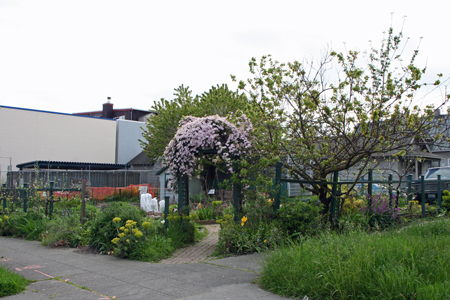Science experiments are known for happening in research labs and petri-dishes, but local community gardens, known as P-Patches, usually aren’t in the mix. However, a new research project aimed at monitoring bee populations needs these gardens for just that.

P-Patch on 14th Ave NW
In recent years, bees have gotten a lot of attention for their sudden population declines and the phenomenon known as “colony collapse disorder.” Scientists in the Department of Biology at the University of Washington have launched a project which will track the number and diversity of native bee populations around the Seattle area. “Native bees do a lot of important pollination work. Up to seventy-five percent of crop species benefit from bee pollination,” said Jeff Riffell, an assistant professor of biology at UW.
Bees and other pollinators are critical for the survival of many types of plants and humans as well; roughly one-third of what we eat depends on pollination. Members of the Urban Pollination Project met with P-Patch leaders to recruit local gardeners to help with the project. Gardeners who choose to join the project are provided with specially selected tomato plants and will then act as citizen scientists by monitoring the plants and collecting data.
Scientists will use data collected at these P-Patches to determine the effects of environmental influences on the bees and, hopefully, find out what is behind these plummeting populations. It should also improve crop production in these urban gardens. “The response has been fantastic!” said Riffell. “Right now we have eight P-Patches involved and more than 100 participants.” Riffell explained that these collaboration projects, between citizens and researchers, benefits both groups in unique ways. Scientists benefit because they receive help collecting data to complete projects that otherwise would not be possible and citizens gain hands-on research experience.
It’s a mutually beneficial relationship, he jokes, “Not unlike the mutually beneficial relationship between plants and pollinators!”
The project is still in early stages but it’s off to a great start. Multiple members of P-Patches are involved and Riffell says that’s great because it ensures cross pollination will occur between the neighboring plants at a given site. Riffell sees projects likes this becoming more popular in future years across the US, and says they are meaningful because they involve the public in scientific research, and provide data that would normally be near impossible to collect. He says it also provides a way for scientists to connect with members of the public that often have decades of experiences with particular plant or animal species.
